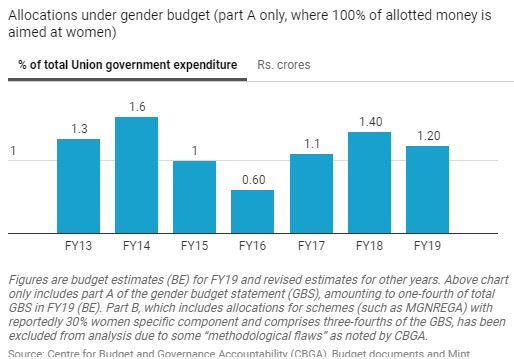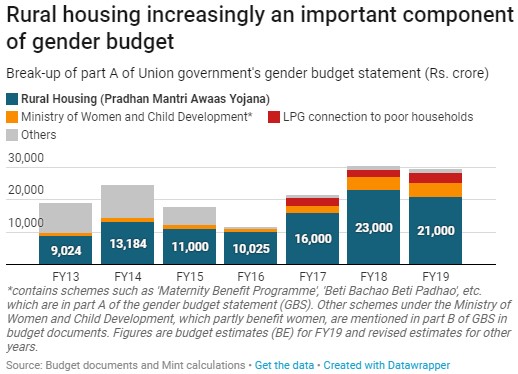Focus: GS-II Social Justice, GS-III Indian Economy, Prelims
Why in news?
- Budgetary allocations for “100% women-specific programmes” in 2018-19, as listed in Part A of the Gender Budget Statement (GBS), declined.
- Despite some sops to women: a cut in provident fund contribution, and 80 million free gas connections for poor women, a closer examination of allocation of funds reveals that the budget had very little for women in it.
Pradhan Mantri Awaas Yojana -Gramin (PMAY-G)
- The gender budget is organized in two parts, A and B.
- The biggest component of GBS (Part A) in recent years has been the subsidized rural housing programme: the Pradhan Mantri Awaas Yojana -Gramin (PMAY-G), formerly called the Indira Awaas Yojana.

- However, the PMAY-G is not targeted specifically towards women.
- The scheme guidelines do not specify any fixed amount of money or share of houses to be granted to women, though female-headed households without a male member, or households having a single girl child, are given preference as beneficiaries.
- Though budgetary allotment for this scheme has shot up in recent years, houses built for women have fallen, both in absolute numbers and as a share of total houses built.

- Lack of demand is most probably not a reason for the fall in houses built for women. Census 2011 puts the total number of female-headed households in rural India at about 17.5 million.
- Out of them, 62%, or about 10 million households, live in kutcha (temporary) houses.
- Despite this apparent need for pucca houses, only about 5 million houses for women have been built under PMAY-G since 2010-11, according to data retrieved on 18 February.
- It’s thus misleading to include entire allocation for PMAY-G in gender budget especially when the number of houses built for women have been falling.
- Both centre and states need to take accountability for the slow completion rate of houses and disbursal of funds.
Other Schemes under MWCD
- The government has increased allocation for some schemes under the MWCD, such as the maternity benefit programme, Beti Bachao, Beti Padhao etc.
- The maternity benefit scheme provides a cash assistance to mothers for their first delivery to compensate wage loss.
- Spending on anganwadi services, or the “core Integrated Child Development Services”, has increased only marginally.
- Anganwadi services are the main mechanism by which the government administers programmes to improve the health and nutrition of pregnant women, nursing mothers and children up to six years of age.
- States have also neglected their duty in expanding this important programme. Some have a considerable deficit in the number of operational anganwadi centres as against the number sanctioned.



